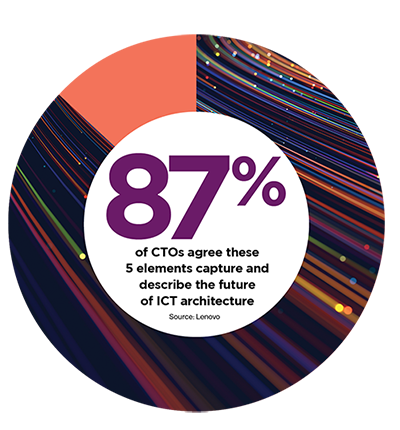Building the backbone for innovation, speed and thriving humanity

From AI-powered platforms that can detect abnormal activities in supermarkets, to edge servers helping preserve biodiversity in remote locations, today’s technologies drive innovation in ways never before imaginable. “Innovation serves the purpose of making our life better, our work more productive, and our planet more sustainable,” says Yang Yuanqing, CEO and chairman of Lenovo.

Technology leaders are reimagining an infrastructure where multiple technologies join to spur innovation in a secure, compliant, and user-friendly environment. Long gone are the days of “traditional IT and its client devices, servers, data centers, and on-premises applications,” says Yuanqing. He says traditional IT, shorthand for “information technology,” is being replaced by what Lenovo calls “new IT,” or “intelligent transformation.” Yuanquing explains that “The new IT enables digital transformation based on five key elements: smart devices, edge computing, cloud computing, high-speed networks, and artificial intelligence. This new IT architecture can create countless opportunities.”
This technology paradigm promises to support innovation and boost employee productivity, and also to power AI, revolutionize how enterprises use data, support business agility, and confront climate change with sustainable solutions.
The five elements of new IT
Although new technology and powerful applications are constantly emerging, Lenovo identifies five key components of a future-ready IT environment: smart devices, edge computing, cloud computing, high speed networks such as 5G, and AI. This definition resonates with technical leadership too, says Yuanqing, citing a 2022 Lenovo global research study of 500 chief technology officers in which four out of five CTOs agree it “captures and describes the future of information communications technology (ICT) ‘extremely’ or ‘very well.’”
Smart devices connect AI to human problems:According to Statista, the number of internet of things (IoT) devices worldwide will reach 29 billion IoT devices by 2030. IoT’s exponential growth—smart devices empowered by advanced sensors—provide a wide range of industries with competitive advantages.
Manufacturers can use smart devices like robots to stand in for workers in dangerous or remote workspaces, and accelerate and automate assembly lines. For example, Lenovo’s Daystar Robot works remotely in real time using telepresence and teleoperation and learns tasks as it goes. The robot is operated by a streaming augmented reality headset with 3D video to give the user a realistic view of the work being done. The user’s head position controls the robot arm, and a handheld device controls movements.
Edge computing helps data eliminate boundaries:Processing volumes of data can lead to performance issues. In response, many organizations are turning to edge computing, which processes data close to the source to enable fast and real-time analysis and response, while maintaining privacy and security requirements. “Edge computing allows data to be treated closer to where data is generated—directly at the edge site, lowering latency for faster response times, increased agility, and greater resilience,” says Yuanqing.
For example, Kroger, one of the largest grocery chains in the United States, teamed with Lenovo and visual AI technology provider Everseen to build a system of secure self-checkout kiosks. AI servers capture unstructured data at each checkout from 20 high-resolution cameras. The system detects if an item is not scanned, and prompts the customer to rescan. It can also ping an associate’s mobile device. Since this requires enormous computing power, an edge solution processes the data near the source. “Over 75% of checkout errors can be corrected without employee intervention,” says Yuanqing.
And global biodiversity nonprofit Island Conservation uses edge computing to bridge 400 miles of Pacific Ocean. At Robinson Crusoe Island, one of the most remote places on Earth, it uses camera traps to document endangered and invasive species. Camera data used to be stored on a hard drive and periodically flown to Santiago, Chile to process, taking as long as three months. Today, edge computing data centers process data on the island—time-savings that can save lives. “The Island Conservation team can process six months’ worth of visual data within just one week, enabling them to draw analytical insights within minutes instead of weeks,” Yuanqing says.

Cloud computing provides connection:If the pandemic taught technology leaders anything, it’s that public, private, hybrid, and multicloud computing is imperative for fast and agile services and development.
“Normally, we wouldn’t think of tablets as life-saving equipment, but when emergency hospitals needed to be built during the Covid-19 outbreak, these devices and innovative infrastructure played a critical role,” says Yuanqing.
“In tough times, like the pandemic, it was new IT that kept us connected, productive, and engaged.“ He continues, “The public cloud became more popular by providing the flexibility, scalability, and on-demand accessibility that we needed at the time. But, many enterprise applications and data are still running and stored in private cloud or on-prem data centers. In fact, we will continue to see the co-existence of private, public, and hybrid cloud for compute, storage, and network needs.”
The same Lenovo study found that cloud, software, and computing are key components for the future of a hybrid work environment, with 84% of respondents optimistic about the future of hybrid cloud.
5G networks enable innovation and flexibility:Connecting the essential components of a new IT architecture requires fast, efficient, and customizable networking. The answer: 5G—the next generation of mobile wireless voice and data communication technology. The 2022 Lenovo study also found that 72% of CTOs see opportunities for their companies to use 5G multiaccess edge computing (MEC) even more with the demand for hybrid options dominating the workplace. “The popular hybrid work model that many companies have adopted over the last three years is only possible with a high-speed network,” says Yuanqing.
AI tools mimic human intelligence to solve problems:By combining data, computing power, and sophisticated algorithms, AI can handle much more data much faster than a human worker, can be adjusted by users to accommodate change, can help users learn better processes, and can help anticipate risks such as cost overruns, accidents, and maintenance needs. Using multiple AI technologies and optimized algorithms, Lenovo Research created new processes for its manufacturing facility that dramatically improved production planning processes, with some six-hour processes cut to 90 seconds. Lenovo estimates the AI solution improved order fulfillment by 20% and productivity by 18%.
Consider that a single PC order will launch a series of complex tasks across multiple production lines, and requires alignment of thousands of parameters, such as employee schedules, materials, production processes, and equipment statuses. Lenovo’s largest manufacturing base for PCs, LCFC Electronics, processes up to 690,000 orders per year. While accounting for these large-scale calculations is a challenge for people, an AI engine can easily carry them out, and can flexibly make real-time adjustments for broad or granular objectives. The AI solution’s autonomous learning ability also means the more it operates, the smarter it becomes. “This smart solution has also improved energy efficiency and reduced greenhouse gas emissions by thousands of tons a year,” says Yuanqing.
A look to the future
Technologies such as smart devices, edge computing, cloud computing, 5G, and AI are facilitating a shift from information technology to intelligent transformation. “New IT is shaping the future in many innovative ways,” says Yuanqing. “In the future, the objects you work on, the colleagues you work with, the environment you work in, and the outcome you deliver might all be real or virtual, ranging from AI assistants and digital twins to the metaverse.”
As always, while change surges ahead, technology executives must carefully consider the real-life outcomes of deploying new IT infrastructure. Security, compliance, and usability standards must still be upheld. “Environmental, social, and governance (ESG) goals must be a major consideration,” says Yuanqing. “In the future, every element of new IT architecture must incorporate ESG. When you assess the returns on innovation, it’s not just financial payback but also social impact.”
This content was produced by Insights, the custom content arm of MIT Technology Review. It was not written by MIT Technology Review’s editorial staff.
